Relationship Spread #1
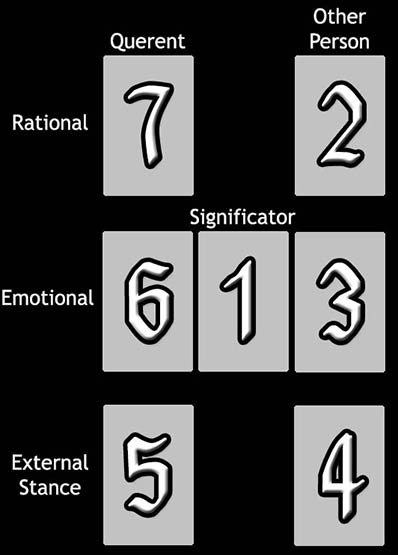
Difficulty: Easy
This tarot spread is easy to read, like a convenient chart. In this spread, court cards generally indicate actual people with the same characteristics. Knights (or corresponding princes, but not kings) and queens are meant to represent actual men and women in this tarot spread. Look for patterns in the cards as always.
Card #1 is the overall significator of the relationship. The two columns on either side of the significator characterise each individual's role in the relationship. The relationship does not have to be romantic. In fact, it could be a relationship between a person and a group, or even how two groups relate.
The top row, cards #7 & #2, is about the conscious thoughts of each person, or what they think about the relationship and likewise how they view their partner.
The middle row, cards #6 & #3, reveals the way each individual feels about the other. Emotional awareness corresponds to a person's unconscious thoughts that run deep, affecting a person in ways he or she is not fully aware of.
The bottom row, cards #5 & #4, represents the way each person behaves, in other words the stance taken regarding the relationship. The way a person acts may be genuine, but sometimes people are phony and manipulative, so it is best to weigh this card against the other person's cards to determine how they match up.
Your Relationship #1 Reading
You |
Other Person |
||
Thought |
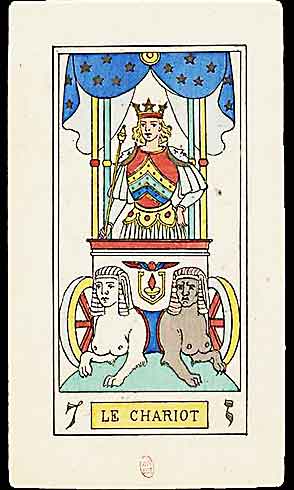 VII – The Chariot |
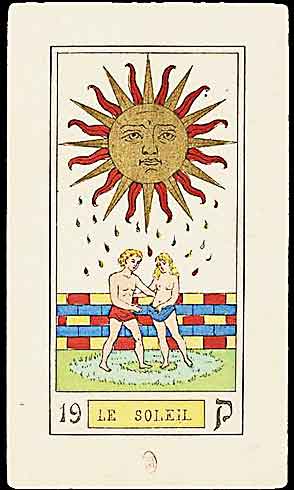 XIX – The Sun |
|
Emotion |
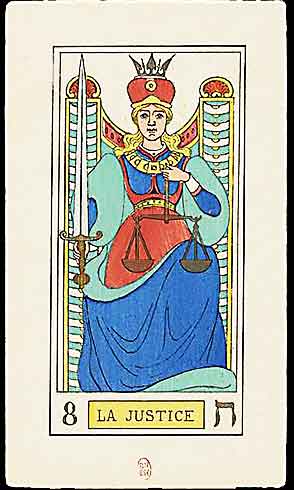 VIII – Justice |
The Significator 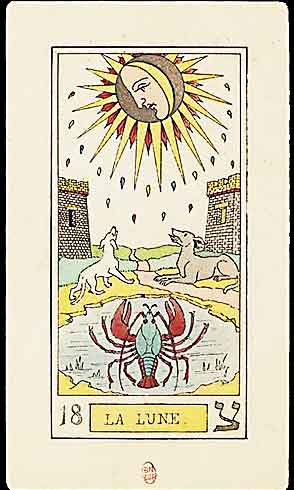 XVIII – The Moon |
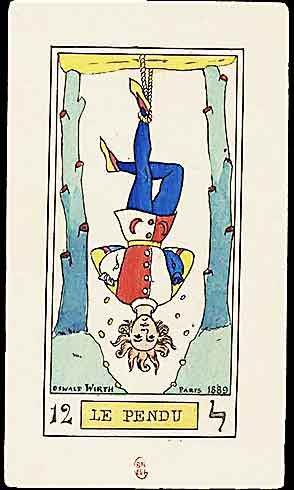 XII – The Hanged Man |
External Stance |
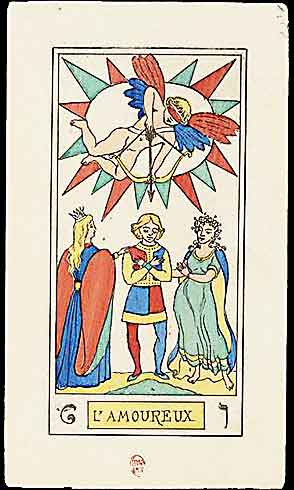 VI – The Lovers |
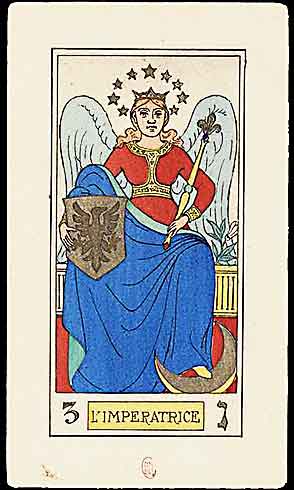 III – The Empress |

The Significator
XVIII – The Moon
The Moon signifies illusion, intuition, and the subconscious mind. It represents the mystery of the unknown, hidden fears, and the need to trust inner guidance while navigating uncertainty.
Symbolism: The Moon is depicted with two dogs howling at the moon, symbolising the pull of primal instincts. A crayfish crawls from the water, representing the subconscious emerging into consciousness. The path leads towards a distant horizon, symbolising the journey through confusion to clarity.
In Relationships: Illusions in relationships, emotional confusion, or hidden feelings. Trust your intuition to navigate these uncertain waters.
In Work: Uncertainty or the need to trust your instincts. Hidden factors may influence the situation.
Spiritually: A time to confront fears, listen to your inner voice, and seek clarity in moments of doubt.
When ill-dignified: Deception, illusion, or being misled by false hopes or unclear situations.

The Querent's Thoughts
VII – The Chariot
The Chariot represents victory, control, and determination. It signifies the ability to overcome obstacles and navigate life's challenges through focus and willpower.
Symbolism: The charioteer rides a chariot drawn by two sphinxes, symbolising opposing forces that must be balanced. The chariot is adorned with symbols of conquest, and the figure wears a crown, signifying authority and triumph.
In Relationships: A relationship driven by effort and mutual determination, or one that requires balance and compromise.
In Work: Triumph through perseverance, conquering challenges with focus.
Spiritually: A journey of self-mastery, overcoming inner struggles, and moving forward with purpose.
When ill-dignified: Recklessness, lack of direction, or being pulled in conflicting directions.

The Other Person's Thoughts
XIX – The Sun
The Sun represents clarity, success, and vitality. It signifies moments of joy, abundance, and realising one's potential.
Symbolism: The Sun shines gloriously over a youthful couple, symbolising innocence, energy, and optimism. A multi-coloured brick wall shelters them, representing protection, growth, vitality, and success. The clear sky suggests obstacles are removed and clarity reigns.
In Relationships: Joyful, open-hearted love. The Sun represents happiness, clear communication, and successful partnerships.
In Work: Success, recognition, and the fulfilment of goals. Positive energy surrounds professional endeavours.
Spiritually: Enlightenment and the ability to see the truth clearly.
When ill-dignified: Arrogance, overconfidence, or a tendency to overlook important details in the pursuit of success.

The Querent's Emotions
VIII – Justice
Justice represents balance, fairness, and accountability. This card calls for the resolution of disputes and alignment with truth and fairness in all areas of life.
Symbolism: Justice sits with a sword in one hand and scales in the other, symbolising impartiality, truth, and balance. Her crown and steady gaze emphasise her authority over matters of fairness.
In Relationships: A balanced relationship or the need to resolve unresolved issues with fairness and integrity.
In Work: Legal matters, contracts, or decisions that require careful evaluation.
Spiritually: A reminder to live truthfully, aligning actions with higher principles.
When ill-dignified: Dishonesty, imbalance, or the refusal to accept responsibility for one's actions.

The Other Person's Emotions
XII – The Hanged Man
The Hanged Man symbolises suspension, sacrifice, and a shift in perspective. This card represents moments when one must release old beliefs or attachments to gain deeper insight and understanding.
Symbolism: The Hanged Man is depicted hanging upside down, suspended by one foot. His serene expression reflects acceptance and surrender, as he finds wisdom through a change in perspective. His hair resembles a crown symbolising enlightenment and the illumination gained through this pause.
In Relationships: A period of reflection, where relationships may need to be reassessed. It could also suggest a sacrifice for love or personal growth within relationships.
In Work: A time for letting go of old ways of thinking, re-evaluating goals, or waiting patiently for a shift in circumstances.
Spiritually: A time for surrender and spiritual enlightenment, achieved through a different perspective.
When ill-dignified: Stagnation, indecision, or an unwillingness to make necessary sacrifices for growth.

The Querent's External Stance
VI – The Lovers
The Lovers represents choice, duality, and the connections that shape our lives. This card often signals a critical decision between love and duty, passion and responsibility.
Symbolism: A young man stands between two women, representing virtue and temptation, while a winged figure above aims a bow and arrow, guiding his choice. The lush background reflects the complexity and growth that relationships bring.
In Relationships: Choices in relationships, including romantic triangles, commitment, or the deepening of bonds.
In Work: A crossroads where personal values must be aligned with career decisions.
Spiritually: A call to balance inner conflicts and unite dualities in the quest for harmony.
When ill-dignified: Indecision, infidelity, or superficiality in relationships.

The Other Person's External Stance
III – The Empress
The Empress embodies creativity, fertility, and nurturing energy. She symbolises the fruitful aspects of life, from creativity to personal growth, and encourages abundance in all forms.
Symbolism: Adorned with a crown of stars, she sits in a lush, fertile garden, holding a sceptre and shield. These symbols signify both authority and protection. The crescent moon beneath her feet connects her to cycles of intuition and growth.
In Relationships: Nurturing love, emotional bonds, or the creation of something new in a relationship, such as a family.
In Work: Success in creative ventures, productive work, and harmony.
Spiritually: Connection with natural and cosmic cycles, alignment with divine timing.
When ill-dignified: Stagnation, overindulgence, or the misuse of creative energy.